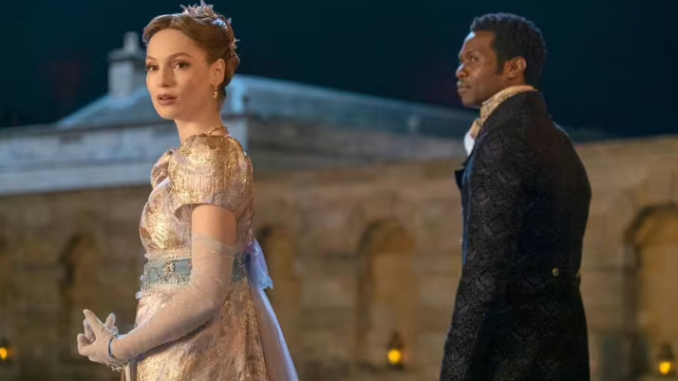
This article contains spoilers from Julia Quinn’s Bridgerton novel When He Was Wicked and potential spoilers for the show in the future. Bridgerton fans were divided earlier this year after the third season premiered, with the show’s writers deviating from author Julia Quinn’s source material by gender-swapping anti-hero Michael Stirling with the seductive libertine Michaela Stirling (played by Masali Baduza).
In a scene late in the season, newlywed Francesca Bridgerton (Hannah Dodd) is left speechless upon meeting Michaela after her wedding to John Stirling, Earl of Kilmartin (Victor Alli).
Compared to the silence between Francesca and John during their courtship, she is instantly drawn to Michaela. The moment mirrors the reaction of her mother, Violet Bridgerton (Ruth Gemmell), when she first meets her future husband, Edmund Bridgerton (Rupert Evans). There’s a clear chemistry between the two women, and a hint at a possible lesbian romance between Francesca and Michaela.
While the Bridgerton-verse has its fair share of quirky storylines, including Benedict Bridgerton (Luke Thompson) being bisexual; the secret romance between Henry Granville (Julian Ovenden) and Lord Wetherby (Ned Porteous); and the warm romance between Queen Charlotte’s Young Brimsley (Sam Clemmett) and Reynolds (Freddie Dennis), these have always been side plots.
The romance between Francesca and Michaela will mark the beginning of Bridgerton, and their story is expected to be inspired by Quinn’s sixth novel in the series, When He Was Wicked. The book focuses on a widowed Francesca who finds love with Michael, the cousin of her late husband John Stirling.
Bridgerton isn’t known for its historical accuracy, with its hoods for elaborate berets and oversized puffed sleeves, not to mention its dated instrumental pop music from the likes of Pitbull and Taylor Swift.
What’s more, spin-off series Queen Charlotte has established Bridgerton as an alternate universe, reimagining the white German monarch as a mixed-race woman (India Amarteifio) and following the rise of a multicultural British society following her marriage to King George III (Corey Mylchreest). Bridgerton has thus set itself in a fictional historical setting, allowing for rich and varied storytelling – but audiences may be surprised to learn that a lesbian love story might be more authentic to the era than previously thought.
Speaking exclusively to Express.co.uk, Professor Charles Upchurch of Florida State University said of the potential storyline: “Discretion is still required, but being a widow would make such a romance considerably easier. A widow would have more control over her time and finances than other women, and she would be fulfilling the main expectations society places on her.”
A lesbian relationship “is possible” as long as it is “presented as a close friendship” and does not “subvert” a woman’s duties in her various roles as daughter, wife or mother with the patriarchal laws of the time “designed to make all women legally, socially and financially dependent on men”. There are instances of lesbian romances, and these come to light when women “step outside” the constraints of those roles with these characters “to scandalous effect or worse”. Professor Upchurch cites the 1810 case of Jane Pirie and Marianne Woods, whose school was closed after they were accused of having a sexual relationship by a student. The women also faced persecution following the accusations.
“We have evidence of women being romantically and sexually attracted to women of all social classes during the Regency period, and records of the many different ways in which women thought about and expressed their desires for other women,” he explains. Likewise, Professor Upchurch says class also had an impact on the existence of lesbian relationships during the Regency, with higher social status allowing women “more opportunities” to pursue same-sex relationships than those in lower positions.
The 1780 case of Eleanor Butler and Sarah Ponsonby, who ran away together, had a happy ending after their wealthy Irish family allowed them to live together in the Welsh countryside. The couple became known as The Ladies of Llangollen and even attracted the attention of Queen Charlotte and Anne Lister.
It is no surprise that Lister – widely regarded as the “first modern lesbian” and whose life was dramatised in the BBC and HBO miniseries Gentleman Jack – came from a wealthy family and broke boundaries in the extent to which she openly related to others.
